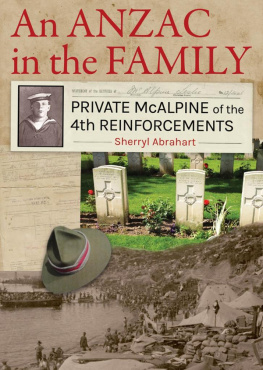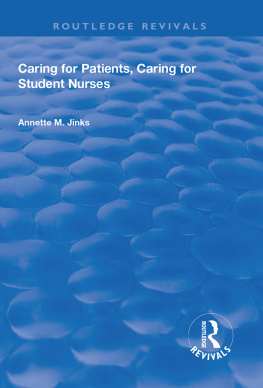PETER REES has been a journalist for forty years, working as a federal political correspondent for the Melbourne Sun, the West Australian and the Sunday Telegraph. He is author of The Boyfrom Boree Creek: The Tim Fischer Story (2001), Tim Fischers Outback Heroes (2002), and KillingJuanita: A true story of murder and corruption (2004), which was a winner of the 2004 Ned Kelly Award for Australian crime writing. He lives in Canberra and is currently writing a book about Australias desert campaigns.
The Other
ANZACS
The Extraordinary Story of
our World War I Nurses
PETER REES

First published in 2008
This paperback edition published in 2009
Copyright Peter Rees 2008
All rights reserved. No part of this book may be reproduced or transmitted in any form or by any means, electronic or mechanical, including photocopying, recording or by any information storage and retrieval system, without prior permission in writing from the publisher. The Australian Copyright Act 1968 (the Act) allows a maximum of one chapter or 10 per cent of this book, whichever is the greater, to be photocopied by any educational institution for its educational purposes provided that the educational institution (or body that administers it) has given a remuneration notice to Copyright Agency Limited (CAL) under the Act.
Allen & Unwin
83 Alexander Street
Crows Nest NSW 2065
Australia
Phone: (61 2) 8425 0100
Fax: (61 2) 9906 2218
Email: info@allenandunwin.com
Web: www.allenandunwin.com
National Library of Australia Cataloguing-in-Publication entry
Rees, Peter, 1948
The other Anzacs : nurses at war 1914-1918 / Peter Rees.
ISBN: 978 1 74175 549 7 (hbk.)
ISBN: 978 1 74237 118 4 (pbk.)
Includes . Bibliography.
Australia. Army. Australian Army Nursing Service.
New Zealand. Army. Nursing Service
Military nursingAustralia.
Military nursingNew Zealand.
World War, 19141918Participation, Female.
World War, 19141918Medical care.
Women in war.
940.47594
Set in 11/17 pt Minion MT by Midland Typesetters, Australia
Printed and bound in Australia by Griffin Press, Adelaide
10 9 8 7 6 5 4 3 2 1
For Sue, who has shared this journey.
CONTENTS


I have attempted to tell the story of the war through the eyes of particular women, using their diaries and letters to show the conflicts effect on them professionally and personally. This book is not intended as a definitive history but more as a representative account, in the context of the unfolding war as it was seen by a few representing the many in Egypt, Lemnos, the hospital ships and the Western Front.
Throughout the war, staff nurses and sisters were addressed as Sister, with matrons generally being called Miss. The staff nurses did not like being referred to as such, preferring to be called Sister. I have mostly used Sister in titles, but Nurse and Staff Nurse are used where necessary. I have also standardised spelling and capitalisation for readability.
While men fight one another, women tend the wounded, and there canbe no doubt at all but that theirs is the nobler part. Naturally enoughthe eyes of the world are on the firing line and sometimes the workof the nurses, from the very firing line to the hospitals is overlooked.It was ever thus. Those who scar the tree of life, a great thinker oncesaid, are remembered by the scars, but those who water its roots havenothing by which they may be known. But theirs is the tree.
Christchurch Star, 3 November 1915

As nurses in Australia and New Zealand saw it, the issue in 1914 was quite simple. They wanted to be there, with their boys, when they went to war. And the Anzac boys wanted the women there, too, with them on the other side of the world. It was not only their nursing expertise, they were a link to home. As one Australian sister at a hospital in France noted, they always knew when wounded Anzacs arrived: If they are not too ill they generally call out Hullo Australia or some such remark, they know our uniform from the English sisters. How we do love our dear brave boys.
Another sister captured it this way in a letter home from a hospital on Malta: You dont know [how] these boys of ours love to come across an Australian woman, and then when they saw us they were nearly too shy to come and speak to me... poor dears, I would do any mortal thing for them. Like so many of her boys from the bush, Narelle Hobbes, the former matron of Brewarrina Hospital in far western New South Wales, died on active duty before the war ended.
The Great War was the first test of the fledgling Army nursing services of Australia and New Zealand. More than forty Australian civilian nurses had served officially in the 18991902 Boer War in South Africa, together with several more from Australia and New Zealand who went either individually or in independent units. But the Great War was the first time nurses were part of dedicated Army servicesthe Australian Army Nursing Service (AANS) and the New Zealand Army Nursing Service (NZANS).
The AANS was a trained civilian reserve of the Australian Army Medical Corps. It was established when the various state nursing services joined together. The nurses had done their training in rural and urban hospitals. As civilians, they had limited knowledge of military matters when war was declared.
The NZANS was not fully established until shortly after the Great War began, by which time Australian nurses were already in the field. New Zealand nursing leaders told the government on New Years eve 1914 that, as with Australia, if the sons of New Zealand were serving the Empire in the field it was only right that her daughters, who were able and willing, should be allowed to do so too.1 In the years ahead, New Zealand and Australian nurses would often work side by side in military hospitals tending their wounded compatriots, and soldiers from other countries as well.
A wave of patriotism swept Australia and New Zealand when war was declared on 4 August 1914. Anti-German sentiment was strong. Men walked long distances to enlist in the Australian Imperial Force (AIF), and womens voluntary organisations were soon established to assist the war effort in any way they could. In New Zealand, men joined the New Zealand Expeditionary Force (NZEF) with similar enthusiasm. In Melbourne, an over-zealous mob attacked the German Club and Consulate. German citizens were quickly rounded up and interned. A year later, the town of Germanton, in the New South Wales Riverina, would change its name to Holbrook. By 1918, from a population of fewer than five million Australians, 331, 781 men would serve overseas, of whom nearly 62, 000 would be killed and 153, 500 would be wounded or gassed. In New Zealand, with a population of 1.1 million, more than 128, 000 enlisted. Of these, more than 16, 000 would be killed and 41, 300 become casualties.
The declaration of war brought an immediate surge of volunteers among trained nurses keen to become military nurses. Waiting lists were so long for overseas postings that at least 130 nurses chose to sail to England to join the Australian Army Nursing Services British equivalent, Queen Alexandras Imperial Military Nursing Service, a recognised body within the Army. Several New Zealand nurses joined the same service. The Australians who left soon found that transferring to their own countrys nursing service would not be easy. Other Australian nurses and some women doctors joined private medical units in Europe and Britain, such as the Scottish Womens Hospital Unit, which worked under dreadful conditions in Serbia.
Next page
















